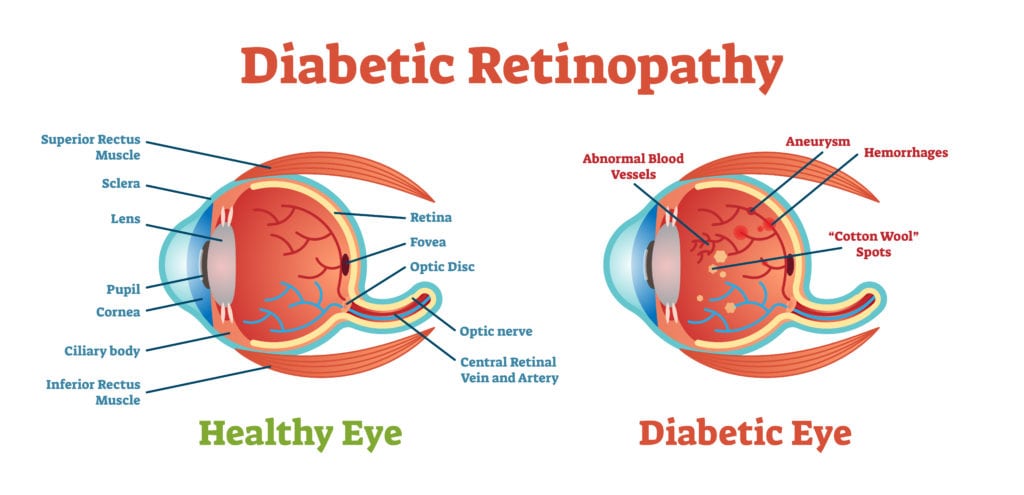
Diabetic eye disease encompasses many eye conditions that can affect a patient’s vision due to having diabetes. These diseases include diabetic retinopathy, diabetic macular edema (DME), cataract, and glaucoma. All of these conditions can lead to severe vision loss or even blindness.
Diabetic Retinopathy is the most common cause of vision loss in those who have diabetes. It occurs when the high blood sugar from diabetes damages the blood vessel in the retina, causing them to hemorrhage, distorting the patient’s vision. Scarring and cell loss can occur when new abnormal blood vessels try to grow on the retina in its advanced stages. Diabetic retinopathy can also lead to diabetic macular edema.
Diabetic Macular Edema (DME) occurs when there is fluid build up in the macula (part of the retina). The macula is in charge of face recognition and the straight-ahead vision you rely on while reading and driving. DME is the leading cause of vision loss in people with diabetic retinopathy and it can happen at any stage, affecting about half of all people with the disease. The longer a person has diabetes, the greater risk they are at for developing diabetic retinopathy. About 40 to 45 percent of all Americans with diabetes have some degree of diabetic retinopathy but only half of those are aware of it. This percentage only notices it once it starts to affect their vision because there are usually no symptoms. If the abnormal blood vessels on the retina start to bleed, it can cause the patient to see spots and floaters. If not treated right away, it can increase the risk for DME along with permanent vision loss. This is why it is so important that diabetic patients get yearly comprehensive dilated eye exams to try and prevent DME from progressing.
Diabetic Retinopathy Symptoms
- Blurred vision
- Spots or floaters
- Difficulty distinguishing colors
- Difficulty with night vision
Cataracts are another big problem that diabetic patients face. A cataract is when the natural lens of the eye is clouding, making normal daily life very difficult. Normally when we think of cataracts, we associate them with growing older, but few are aware that they tend to develop earlier in people with diabetes. Adults with diabetes are actually 2 to 5 times more likely to develop cataracts than adults without diabetes. Early cataracts can be treated with corrective lens but once it starts interfering with your vision, cataract surgery will be required.
To learn more about cataracts and treatment options visit our Cataract page or call us today!
Glaucoma refers to a group of disorders that damage the eye’s optic nerve as a result of a build up of high intraocular pressure that can cause damage to the optic nerve. It is currently the leading cause of blindness in the United States, but for adults who have diabetes, the risk is nearly doubled. Just like diabetic retinopathy, glaucoma can go unnoticed until it reaches the advanced stages where permanent damage has already been done. It is important for those who have diabetes to keep regular appointments with an ophthalmologist to watch out for symptoms like:
- Gradual loss of peripheral vision
- Eye pain (possibly accompanied with nausea or vomiting)
- Halos
- Blurred vision